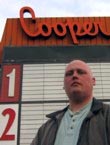|
|
This topic comprises 2 pages: 1 2
|
|
Author
|
Topic: Drive-In Screen
|
|
|
|
|
|
|
|
|
|
|
|
|
|
|
|
|
|
|
|
|
|
|
|
|
|
|
Frank Angel
Film God

Posts: 5305
From: Brooklyn NY USA
Registered: Dec 1999
|
 posted 08-26-2014 02:48 AM
posted 08-26-2014 02:48 AM





quote: Marcel Birgelen
But this thread got me wondering... How is paint ever going to entirely hide the underlying structure of a corrugated steel screen? It's not like "normal" paint has the magical ability to bend light in the right direction, which would be required to hide those artifacts?
Actually, Marcel, the paint doesn't hide the corrugations -- it's just needed to coat the raw metal with a white surface on which to project the image same as a white screen is needed in an indoor theatre. Thing is, focused light projected from a projector's optical system is a single point-source of light which hits the screen surface front on so it will cause minimum to no shadows on minor irregularities in the screen surface (up to a point), thus the corrugations are barely visible and the farther back from the screen the audience sits (in a DI, that's much farther than in a regular cinema), the less the eye can see those corrugations -- it's much like the perforations in an indoor screen. At a certain distance, they become impossible for the eye to resolve and they seem to disappear....so do the corrugations, IF the proper type and size of the corrugations are chosen.
The point at which the corrugations become invisible, just like the size of the perforations, is corrolates directly to their size; the more shallow the corrugations/the smaller the perfs, the shorter the distance it takes for them to become invisible to the naked eye.
DIs (ozoners) and indoor cinemas (hardtops) both need these compromises in the screen to over-come unique and specific physical problems each faces; DIs need the corrugations to keep water from sheeting on the screen surface and indoor cinemas of course need perforations to pass sound to the audience. Both seem to work quite effectively.
| IP: Logged
|
|
Marcel Birgelen
Film God
Posts: 3357
From: Maastricht, Limburg, Netherlands
Registered: Feb 2012
|
 posted 08-26-2014 09:54 AM
posted 08-26-2014 09:54 AM




I've not thought about the effects of water on a large, flat, white surface, so those corrugations actually start to make some sense to me now ![[Wink]](wink.gif) . .
The difference with perforations, of course, is that it's practically just holes in the surface. Light will just pass trough and will not reflect in another direction on the edges of those holes. (It probably will, but the effects are negligible.)
I understand that's a matter of size, structure and relative dimensions, once those corrugations become (virtually) invisible, just like the perforations in a regular "indoor" screen. Then again, I didn't understand why one would build a screen out of this kind of material in the first place.
| IP: Logged
|
|
|
|
All times are Central (GMT -6:00)
|
This topic comprises 2 pages: 1 2
|
Powered by Infopop Corporation
UBB.classicTM
6.3.1.2
The Film-Tech Forums are designed for various members related to the cinema industry to express their opinions, viewpoints and testimonials on various products, services and events based upon speculation, personal knowledge and factual information through use, therefore all views represented here allow no liability upon the publishers of this web site and the owners of said views assume no liability for any ill will resulting from these postings. The posts made here are for educational as well as entertainment purposes and as such anyone viewing this portion of the website must accept these views as statements of the author of that opinion
and agrees to release the authors from any and all liability.
|

 Home
Home
 Products
Products
 Store
Store
 Forum
Forum
 Warehouse
Warehouse
 Contact Us
Contact Us




 Printer-friendly view of this topic
Printer-friendly view of this topic










![[Wink]](wink.gif) .
.


